The Origin and Early Evolution of Birds
About the author

Katie
Introduction
Birds are phylogenetically considered to be members of the theropod dinosaurs; their closest non-avian relatives are the dromaeosaurid theropods. The first known fossil bird is Archaeopteryx, from the late Jurassic of Bavaria, Germany, which is represented by seven skeletons and a feather. There is no fossil evidence from before this time that has been proven to be of avian origin. The fossil record of modern birds began in the early Tertiary (Padian et al., 1998).
There are a lot of anatomical terms used to describe the evolution of birds, therefore diagrams showing the skeletons of a theropod dinosaur, Archaeopteryx and a modern bird are shown in figure one, in order to define most of the terms used.
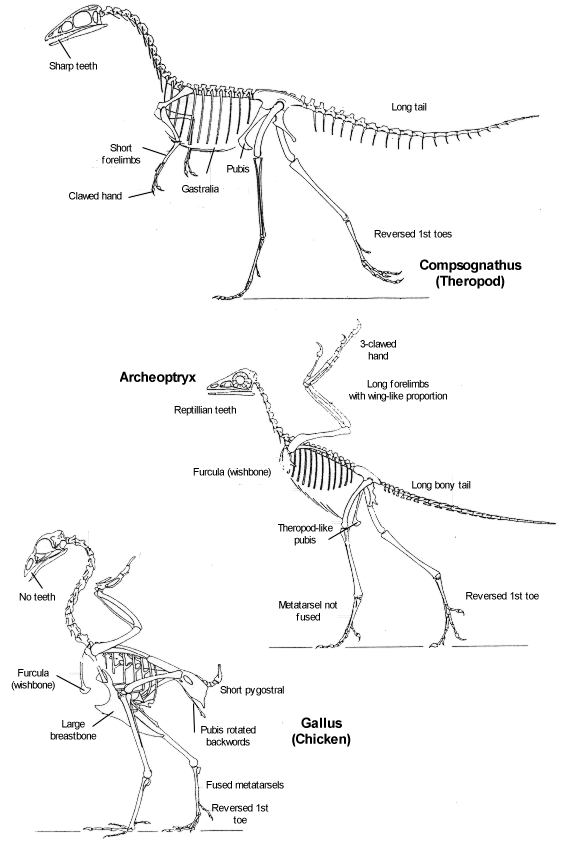
Figure 1: Comparison of skeletons of a theropod dinosaur, Archaeopteryx and a modern bird.
The Origin of Birds
Birds are generally thought to have evolved from small theropod dinosaurs in the mid-late Jurassic, over 150 million years ago. However, it has also been suggested that they evolved from thecodonts, which are primitive archosaurs, or crocodylomorphs. All three theories will be discussed here (Padian et al., 1998).
A cladogram showing the systematic position of birds according to all three hypotheses is illustrated in figure two.
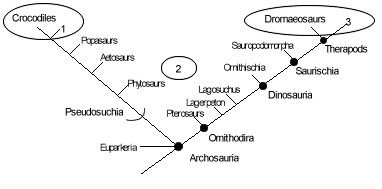
Figure 2: Possible systematic positions of birds. Redrawn from Padian et al (1998).
The Thecodont Hypothesis
The thecodont hypothesis for the origin of birds is characterised by being a default option. This is because it is not due to positive correlation of characters and taxa but due to the negative association with other taxa. It was originally thought that theropods shared more features with birds than any other group. However, at the time there was no evidence for clavicles in theropods, which are the equivalent of the furcula or wishbone in birds. It was thought that clavicles could not have been lost and then re-evolved into furcula and so a more ancient ancestor for birds was sought for. The candidate suggested was the thecodonts from which all other archosaurs are thought to have evolved. A problem is that the archosaurs are a "wastebasket" group containing all archosaurian reptiles that do not fit into dinosaurs, crocodiles or pterosaurs. Hence, they have no diagnostic characters of their own and are not a "good" phylogenetic group. This makes it difficult to compare them with other taxonomic groups (Padian et al., 1998).
The Crocodylomorph Hypothesis
Crocodylomorphs include crocodiles and some Triassic-Jurassic forms that are closely related but not true crocodiles. This hypothesis has fewer problems than the thecodont hypothesis, as crocodiles are a monophyletic group, which can be compared to other taxa. The synapomorphies of birds and crocodiles have been tested, but it has been found that most are general to the archosaurs. Even if these are accepted, there are only 15-20 synapomorphies compared to over 70 with the theropods (Padian et al., 1998).
The Theropod Hypothesis
Cladistic analysis supports this hypothesis and shows that the most closely related group (sister group) of theropods to the birds includes the dromaesaurids such as Deinonychus. There are numerous synapomorphies of the skeleton and skull that link birds and theropods. There have been found a series of skeletal changes in theropods that are considered to be avian. For example, basal theropod dinosaurs have lightly built bones and a foot reduced to three main toes, with the first held off the ground and the fifth lost. Moving through the theropod sequence towards birds, there is a reduction and loss of manual digits four and five, increasing lightness of the skeleton, and a reduction in the number, and partial interlocking, of the tail vertebrae. In coelurosaurs, which include birds, dromaeosaurids and other groups, the arms become longer and the first toe begins to rotate backwards behind the metatarsals. Fused clavicles (furcula) are apparently basal to Tetanurae (carnosaurs and coelurosaurs) and sternal plates are known in a variety of tetanurans. In the pelvis, the pubis and ischium begin to show a greater disparity in length. Finally, in the dromaeosaurids and Archaeopteryx, the pubis begins to point backwards instead of forwards, the anterior projection on the foot of the pubis is lost, the tail becomes even shorter and the hyperflexing wrist joint is present, which allows the action that is crucial to the flight stroke in birds. These features were passed to birds from their dinosaurian ancestors and not specifically evolved for an avian lifestyle (Padian et al., 1998).
The Evolution of Feathers
The first known feathers are from a small coelurosaurian dinosaur called Sinosauropteryx, which has a row of small fringed structures along its vertebral column. Therefore, feathers are not a synapomorphy of birds, they are shared by a broader group within the theropod dinosaurs. This shows that feathers did not evolve specifically for flight (Padian et al., 1998).
Hypotheses for the original function of feathers include insulation, display and camouflage. These are hypotheses are difficult to test, and it seems likely that feathers were used for several different purposes as they are now (Padian et al., 1998).
The Origin of Flight
The origin of flight argument is split into two theories; arboreal, "from the trees down", and cursorial, "from the ground up". These are summarised, and possible landing precision shown, in figure three.
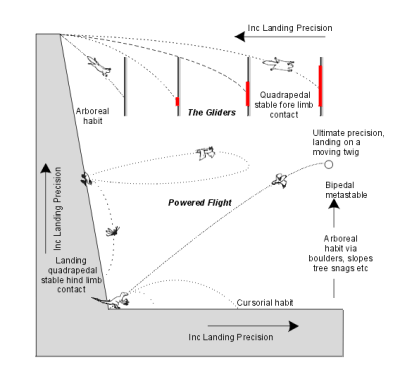
Figure 3: Flying modes showing how mode and type of habit affects landing precision. Redrawn from Padian et al (1998).
The Arboreal Theory
The arboreal theory is more intuitive in that flight evolving from an arboreal gliding stage would seem to be relatively easy. However, this theory has little support from comparative biology as it requires the ability to climb trees and to glide. Neither capacity seems to be present in Archaeopteryx or in theropod dinosaurs. Archaeopteryx has none of the features of typical vertebrate gliders, nor is it aerodynamically designed to fly. It has been argued that the lateral grooves and curvature of the claws are an arboreal specialisation, but these have also been compared to those of ground-dwelling birds. The evidence for an arboreal lifestyle overall is weak. It should also be considered that large theropods such as Allosaurus and Tyrannosaurus have curved claws with deep lateral grooves, and they were obviously not arboreal. Also, palaeobotanical evidence shows an absence of large trees anywhere near the Solnhofen lagoons in which Archaeopteryx is preserved (Padian et al., 1998).
The Cursorial Theory
The cursorial theory is based on the evidence that Archaeopteryx was a strong, agile, biped, and from evidence that birds evolved from small, active, running predators. It has been suggested that feathers were used as nets to capture insects, but it has been shown that this action would cause the proto-bird to lose its balance by throwing off its angular momentum. As an alternative, it was suggested that insects were caught using the teeth with the arms held out laterally. An increased airfoil surface would increase lift and stability. This suggests that flight could have begun by running, leaping and sustaining short, leg-powered glides after prey or away from predators (Padian et al., 1998).
Criticisms of this include the problems of drag and needing to work against gravity. It is biomechanically easier to evolve flight from gliding than from the ground, although this does not indicate that it evolved this way. The other problem is the ground speed that would be required to reach a typical flight speed of 6-7 ms-1. Modern lizards have been reported to reach theses speeds, but it is not known whether proto-birds could reach such speeds. There has been some doubt as to whether selection could improve both the forelimb and hindlimb at the same. However, decoupling of the fore- and hindlimbs was achieved in the coelurosaurs and the tail and hindlimb were progressively decoupled in the earliest birds (Padian et al., 1998).
Any model also needs to account for the evolution of the flight stroke. It has been shown that the immediate sister groups of birds, Deinonychus and the other dromaeosaurs, already had the sideways-flexing wrist joint that in birds is essential to the production of thrust. In dinosaurs, this feature was used as a prey-seizing stroke (Padian et al., 1998).
It would have only taken a slight adjustment of the angle of attack of this predatory stroke to create a suitable vortex wake. By running, leaping and a few such strokes, extension of the time in the air, and eventually flight from the ground up could have evolved. This idea requires no features not already known from fossils. It has been suggested that advantage may have been taken of any ridge or incline and so the model does have an element of the arboreal theory (Padian et al., 1998).
Overall, the evidence seems to point to a modified version of the cursorial theory of bird. Running leaps were aided by wings outstretched for balance, the wings were expanded at the distal ends for increased stability. The leaps were gradually extended by short flapping motions that elaborated the down and forward motion already present in the sister groups of the first birds. Running and leaping may have been enhanced by "ridge-gliding" or jumping from small heights (Padian et al., 1998).
Flight Capabilities of Archaeopteryx
The general consensus is that Archaeopteryx was a weak flier. This is supported by two arguments. The first is that Archaeopteryx lacks evidence of a supracoracoideus system, which in birds is the tendon that powers the upstroke. Experiments have shown that pigeons with a severed supracoracoideus tendon can not take-off from ground level, can not maintain level flight and can not land safely. However, it is questionable whether Archaeopteryx can be compared with modern birds in this way (Padian et al., 1998).
The second argument is that the feathers of Archaeopteryx are asymmetrical, which suggests that it was capable of some flight. However, data shows that the asymmetry is less than that of modern fliers and gliders and this argument is only valid if it is assumed that fossil animals must look exactly like modern ones when performing the same function (Padian et al., 1998).
Generally it is thought that Archaeopteryx could glide as well as most modern birds and fly by flapping to some extent. The evidence for this is; 1) its wing planform and size are like those of some modern weakly flying birds, 2) the flight feathers are well-developed, 3) the sternum was a strong site of origin for flight muscles, and 4) its aerodynamic planform is unlike that of birds that only glide (Padian et al., 1998).
Flight Improvements After Archaeopteryx
Phylogenetic analysis has shown that many of the characteristics associated with the origin of flight were already present in non-avian theropod dinosaurs before birds evolved. Feathers evolved in non-avian coelurosaurs whose forelimbs were too short to bear functional wings. Archaeopteryx had a forelimb longer than the hindlimb, and flight feathers on the wings and long tail feathers. It is thought to have had a fully evolved flight stroke capable of generating thrust as well as lift. The presence of an alula in the early Cretaceous Eoalulavis shows that the wing mechanism that allowed flying at lower speeds and to manoeuvre like living birds evolved early in bird history. Iberomesornis, of the early Cretaceous, has features diagnostic of a perching ability (Padian et al., 1998).
The Cretaceous Radiation
Avians radiated extensively in the Cretaceous, and a cladogram of the basal avian taxa with stratigraphic ranges is shown in figure four.
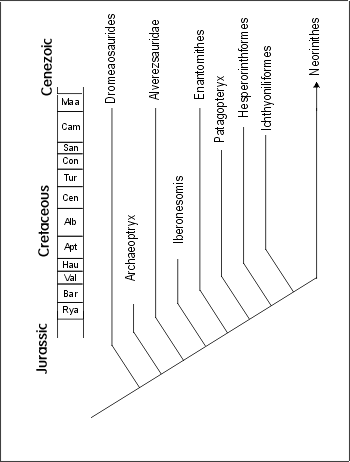
Figure 4: Cladogram of birds
Mononykus
Mononykus, of the Alvarezsauridae, is the most recent dramatic find and occupies the most basal position on the avian family tree. It is the size of a turkey and has a skull with tiny teeth, an elongated neck, and very short and unusual forelimbs (Chiappe, 1995). The phylogenetic position of Mononykus is supported by the presence of several characters diagnostic of Aves. These characters are concentrated in the braincase, the teeth and the tail. Cladistic analysis of dromaeosaurid theropods and birds places Mononykus as the sister taxon of all birds other than Archaeopteryx (Padian et al., 1998).
Mononykus is very unusual, especially its forelimb which is nothing like a flying wing. It is not understood why, so early in avian evolution, flying was abandoned. Also, the function of this strange forelimb is not understood. The rest of the skeleton is not dissimilar to the homologous elements of Archaeopteryx and other early birds. Mononykus is late Cretaceous in age and the split of its lineage from that of other birds must have taken place by the early Cretaceous, and since then autapomorphies may have evolved (such as the forelimb) that should not be used in phylogenetic analysis. It is unknown if Mononykus lost flight secondarily, as less derived members of the clade are not known. (Padian et al., 1998). The skeleton of Mononykus is shown in figure five.
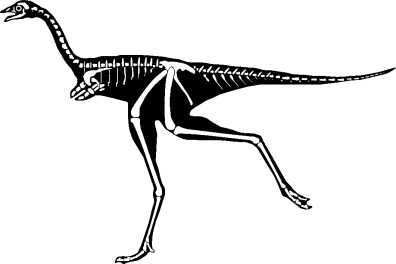
Figure 5: Skeleton of Mononykus, redrawn from Paddin (1998).
Other early birds are providing a more complete picture of the early evolution of birds. The curved foot claws of the sparrow-sized Iberomesornis, of the early Cretaceous, provide evidence for an arboreal habitat, although the tail, pelvis and hindlimb are not much more advanced than in Archaeopteryx (Padian et al., 1998).
Enantiornithes
These are the most diverse and widely distributed group of early birds. They include about 15 taxa from the early Cretaceous, known from all continents except Antarctica. The anatomy of this group is highly variable. The best known skull is from Cathayornis, in which the teeth are unserrated and have constricted bases. This is the same as in all the toothed birds. The furcula is U-shaped and many of these birds have a grasping, perching foot suggestive of an arboreal lifestyle. Other enantiornithines have been interpreted as having wading and aquatic lifestyles. Most were small but some had wingspans of up to 1m across (Padian et al., 1998).
Most of the known Mesozoic avian diversity can be grouped within the Enantiornithes. This clade documents a major radiation of basal birds during the 80 million years of the Cretaceous (Padian et al., 1998).
Patagopteryx
The late Cretaceous Patagopteryx is another basal avian. It was chicken-sized, cursorial and flightless, with reduced wings. It has been interpreted to acquire flightlessness independently from the ratites and other modern flightless birds (Padian et al., 1998).
Ornithurae
The Ornithurae includes Neornithes and its sister groups Hesperornithiformes and Ichthyorniformes. Hesperornis is part of a radiation of secondarily flightless divers from the late Cretaceous. Ichthyornithiformes are known from marine late Cretaceous rocks, they were tern-like, but otherwise little is known about their anatomy (Padian et al., 1998).
Cretaceous Extinctions
None of the groups discussed so far are known to survive into the Tertiary. This has been used as evidence that birds underwent a dramatic Cretaceous-Tertiary bottleneck and then radiated in the early Tertiary. However, the fossil record of birds is so poor compared with other taxa that it is not really possible to distinguish whether extinction was massive or gradual (Padian et al., 1998).
Conclusion
There are several important points that have been raised which are as follows:
- Birds evolved from the theropod dinosaurs. Archaeopteryx is the first known bird but was probably not the direct ancestor of modern birds.
- Birds probably evolved flight from the ground up, possibly assisted by "ridge-gliding" or by jumping from small heights.
- Feathers did not evolve for the purpose of flight. They were already present in coelurosaurian theropods not closely related to those that birds evolved from.
- After Archaeopteryx, bird evolution focussed on the improvement of the flight apparatus. Other changes occurred later.
- Secondary flightlessness evolved several times and arboreal lifestyles may have been adopted early in the evolution of birds.
- The Tertiary bird record is very different to the Mesozoic one, suggesting a possible massive extinction.
To conclude, there is a lot that is still not known about the origin of birds. New fossils need to be found in order to fill the gaps in our knowledge. There are many puzzles, such as the function of Mononykus' unusual forelimb and much more work needs to be done before these puzzles can be solved.
The phylogeny of the early birds is constantly being reassessed and refined with every new discovery. The key to discovering the facts of avian origins and early evolution lies in this phylogenetic analysis.
References
Chiappe, L. M. (1995). The First 85 Million Years of Avian Evolution. Nature, 378, 349-355.
Padian, K., Chiappe, L. M. (1998). The Origin and Early Evolution of Birds. Biological Reviews, 73, 1-42.
 GeologyRocks
GeologyRocks Send to friend
Send to friend